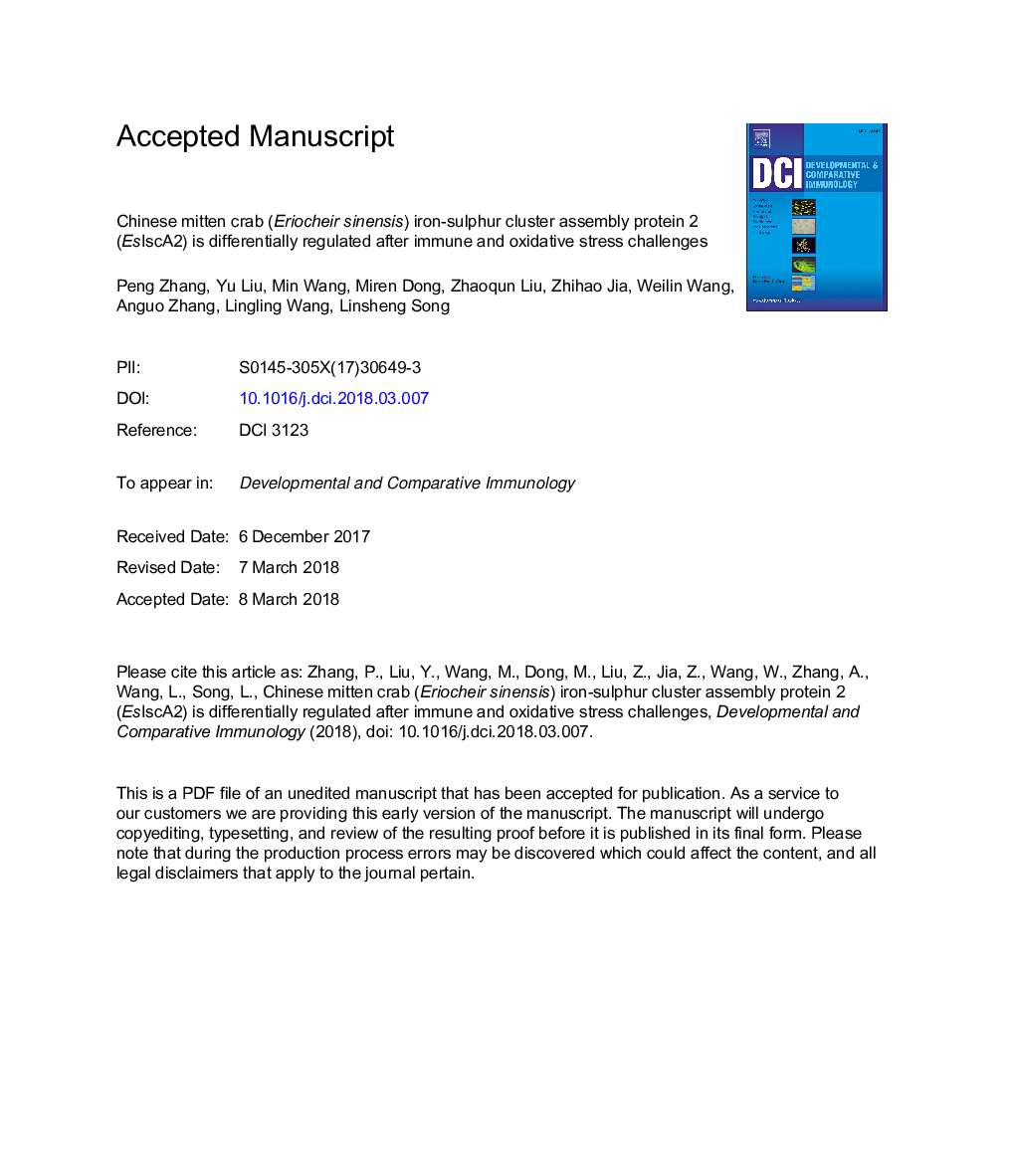| کد مقاله | کد نشریه | سال انتشار | مقاله انگلیسی | نسخه تمام متن |
|---|---|---|---|---|
| 8497737 | 1553548 | 2018 | 49 صفحه PDF | دانلود رایگان |
عنوان انگلیسی مقاله ISI
Chinese mitten crab (Eriocheir sinensis) iron-sulphur cluster assembly protein 2 (EsIscA2) is differentially regulated after immune and oxidative stress challenges
دانلود مقاله + سفارش ترجمه
دانلود مقاله ISI انگلیسی
رایگان برای ایرانیان
کلمات کلیدی
موضوعات مرتبط
علوم زیستی و بیوفناوری
بیوشیمی، ژنتیک و زیست شناسی مولکولی
زیست شناسی تکاملی
پیش نمایش صفحه اول مقاله

چکیده انگلیسی
Iron-sulphur clusters (ISCs), one of the oldest and most versatile cofactors of proteins, are involved in catalysis reactions, electron transport reactions, regulation processes as well as sensing of ambient conditions. Iron-sulphur cluster assembly protein (IscA) is a scaffold protein member of ISC formation system, which plays a significant role in the assembly and maturation process of ISC proteins. In the present study, the cDNA sequence of iron-sulphur cluster assembly protein 2 (designated as EsIscA2) was cloned from Eriocheir sinensis. The open reading frame (ORF) of EsIscA2 was of 507 bp, encoding a peptide of 168 amino acids with a typically conserved Fe-S domain. A tetrameric form was predicated by the SWISS-MODEL prediction algorithm, and three conserved cysteine residues (Cys-93, Cys-158, Cys-160) from each IscA monomer were predicted to form a 'cysteine pocket'. The deduced amino acid sequence of EsIscA2 shared over 50% similarity with that of other IscAs. EsIscA2 was clustered with IscA2 proteins from invertebrates and vertebrates, indicating that the protein was highly conservative in the evolution. rEsIscA2 exhibited a high iron binding affinity in the concentration ranging from 2 to 200â¯Î¼M. EsIscA2 transcripts were detected in all the tested tissues including gonad, hemocytes, gill, muscle, heart, hepatopancreas and eyestalk, and EsIscA2 protein was detected in the mitochondria of hemocytes. The highest mRNA expression level of EsIscA2 was detected in muscle and hepatopancreas, which was about 34.66-fold (pâ¯<â¯0.05) and 27.07-fold (pâ¯<â¯0.05) of that in hemocytes, respectively. After Aeromonas hydrophila and lipopolysaccharide (LPS) stimulations, the mRNA expression of EsIscA2 in hemocytes was down-regulated and reached the lowest level at 24â¯h (0.31-fold, pâ¯<â¯0.05) and 48â¯h (0.29-fold, pâ¯<â¯0.05) compared to control group, respectively. And the expression of EsIscA2 mRNA in hepatopancreas was repressed from 6â¯h to 48â¯h post stimulation (pâ¯<â¯0.05). When the primary cultured crab hemocytes were incubated with different concentrations of H2O2 for 15â¯min, the expression level of EsIscA2 mRNA was significantly repressed to the 0.34-0.44-fold of that in the control group. After A. hydrophila stimulation, the mRNA expression of EsGrx2 was up-regulated at 3â¯h (3.22-fold compared to control group, pâ¯<â¯0.05) and reached the peak at 12â¯h (4.88-fold, pâ¯<â¯0.05). All these results suggested that EsIscA2 had iron-binding capabilities as observed in IscA proteins from other organisms, supporting the role of EsIscA2 as a mitochondrial iron donor for ISC synthesis in Chinese mitten crab. Its differential mRNA expression after immune and oxidative stress challenges suggested the adaptations of ISC synthesis rates to these stress conditions.
ناشر
Database: Elsevier - ScienceDirect (ساینس دایرکت)
Journal: Developmental & Comparative Immunology - Volume 84, July 2018, Pages 343-352
Journal: Developmental & Comparative Immunology - Volume 84, July 2018, Pages 343-352
نویسندگان
Peng Zhang, Yu Liu, Min Wang, Miren Dong, Zhaoqun Liu, Zhihao Jia, Weilin Wang, Anguo Zhang, Lingling Wang, Linsheng Song,